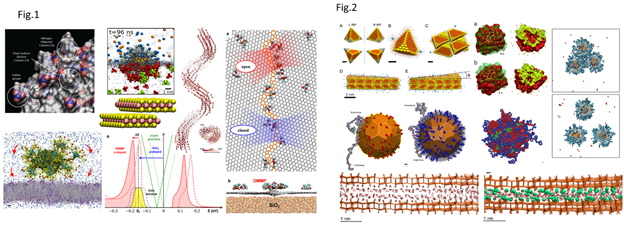Reports: ND653062-ND6: Multiscale Modeling of Nanoparticle Membranes: Structure, Mechanical Properties, and Molecular Filtration
Petr Kral, PhD, University of Illinois at Chicago
FINAL REPORT
Using the provided funding, we have been collaborating during the last two years with the experimental groups of Mark Schlossman (UIC), Vince Rotello (UMASS), Rafal Klajn (Weizmann), Nicholas Kotov (UMICH), Francesco Stellaci (EPFL), Amin Khojin-Salehi (UIC), Tijana Rajh (ANL), Seungpyo Hong (UIC), Nathan Gianneshi (UCSD), Catherine Murphy (UIUC) and others. With MS, VR, RK, NK, and FS we have been working on the self-assembly and activity of nanoparticles, with AS and TR we studied novel materials for electronic transport, molecular sensing, batteries, and catalysis, and with SH, NG, CM and others we worked on the self-assembly of micelles for bio-medical applications.
Using multiscale simulation approaches, we have been able to figure out: 1) What forces control the self-assembly of nanoparticles observed in experiments and how these forces can be modified, 2) what determines the electronic properties of selected nanoscale materials with energy-related applications, and 3) what controls the specific activity of nanoparticles and micelles used in nanomedicines. To be more specific, we have been deciphering the self-assembly of nanoparticles at interfaces of different ionic solutions (MS, VR), in different solutions and ligands (NK, FS), and chiral magnetic columnar structures (RK). We have also examined how a fast CO2 reduction can be realized on MoS2 substrate (AS), what causes a huge selectivity in molecular detection in graphene grain boundaries (AS), and how layered V2O5 material can be used in Mg-based batteries (TR). Finally, we have studied nanoparticles and micelles with applications in nanomedicines (SH, NG, CM). In the attached Figs.1-2, we show some of the systems studied. All these studies were published in top journals (Science, Nature Materials, Nature Communications, JACS, ACS Nano, Faraday Discussions, etc.).
The performed self-assembly studies were truly fundamental, since they have disclosed how atomic-level forces can be responsible for the formation of new materials, their properties, and their activities. The gained knowledge can be used by experimentalists in the design of new materials, filtration membranes, and nanoparticles with active ligands. The same molecular dynamics simulations have also been used to describe nanomedicines, which are used for drug delivery. We are also helping the experimentalists to understand the electronic, catalytic, and sensing properties of novel layered materials with energy related applications.
To address all the above tasks, we have been developing novel modeling approaches, for example, Monte Carlo methods, which can be used in studies of material systems in general. Our students are directly taking part in these processes and readers of our papers are exposed to the results of these studies, where knowledge is gained, processed, and passed from field to field. As a results, the students are extremely well trained, which means that there is a high demand for them. They are truly universal and not afraid of new concepts and approaches. Simply, they gain a common sense about all the necessary steps related to practical science. Since many of our collaborators and their students are chemical engineers, they take the gained knowledge in those areas as well, and ultimately have an impact on the technologies that are developed in these days.
The large number of important results that we obtained through the ACS PRF funding has dramatically impacted the group members who took part in the Projects. The PI has been promoted to a Professor level, Dr. Artem Baskin graduated and received a postdoctoral position at Berkeley Lab, and Mr. Henry Chan has completed his thesis. Other graduate and undergraduate students of the group have also benefited indirectly from the knowledge that we acquire in this research.
Fig. 1 Examples of systems studied in the first year: (left – top, bottom) bio-active particles and nanomedicines interacting with biological membranes, (middle – top) nanoparticles at ionic solution interfaces, catalysis at MoS2, self-assembly of magnetic nanoparticles, (middle – bottom, right) molecular sensing at graphene grain boundaries.
 Fig. 2 Examples of systems studied in
the second year: (upper layer) self-assembly of nanoparticles (chiral sheets,
hollow capsules, cavities), (middle layer) self-assembly of proteins on
nanoparticles, nomedicines, (bottom layer) Mg -based batteries.
Fig. 2 Examples of systems studied in
the second year: (upper layer) self-assembly of nanoparticles (chiral sheets,
hollow capsules, cavities), (middle layer) self-assembly of proteins on
nanoparticles, nomedicines, (bottom layer) Mg -based batteries.











